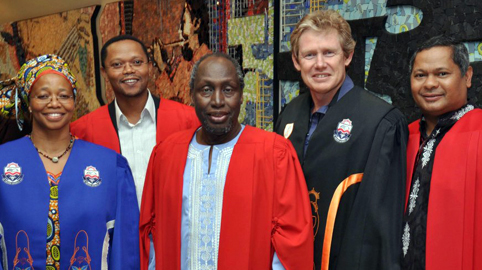 |
|
Attending the lecture were, from left: Dr Choice Makhetha, Vice-Rector: External Relations; Prof Kwandiwe Kondlo, Director of the Centre for Africa Studies;Prof. Ngugi wa Thiong'o; Prof Lucius Botes, Dean of the Faculty of the Humanities, and Prof Andre Keet, Director of the Institute for Reconciliation and Social Justice..
Photo: Stephen Collett
25 May 2012 |
Photo Gallery
Lecture: THE BLACKNESS OF BLACK: Africa in the World Today
Audio of the lecture
Profile of Professor Ngugi wa Thiong'o (pdf format)
“Flowers are all different, yet no flower claims to be more of a flower than the other.” With these words Kenyan writer and one of the continent's most celebrated authors, Prof. Ngugi wa Thiong’o, delivered the tenth annual Africa Day Memorial lecture on 25 May 2012 in the University of the Free State's (UFS) Odeion Theatre on the Bloemfontein Campus. The lecture was hosted by the Centre for Africa Studies.
Long before Prof. wa Thiong’o was led inside the venue by a praise singer, chairs were filled and people were shown to an adjoining room to follow the lecture. Others, some on the university's Qwaqwa Campus, followed via live streaming.
In his speech titled the Blackness of Black: Africa in the world today, Prof. wa Thiong’o looked at the standing of Africa in the world today. He highlighted the plight of those of African descent who are judged “based on a negative profile of blackness”.
Prof. wa Thiong’o recalled a humiliating experience at a hotel in San Francisco in the United States, where a staff member questioned him being a guest of the hotel. He shared a similar experience in New Jersey, where he and his wife were thought to be recipients of welfare cheques. He said this was far deeper than overt racism.
“The certainty is based on a negative profile of blackness taken so much for granted as normal that it no longer creates a doubt.”
Prof. wa Thiong’o said the self certainty that black is negative is not confined to white perception of black only.
“The biggest sin, then, is not that certain groups of white people, and even the West as a whole, may have a negative view of blackness embedded in their psyche, the real sin is that the black bourgeoisie in Africa and the world should contribute to that negativity and even embrace it by becoming participants or shareholders in a multibillion industry built on black negativity.”
“Africa has to review the roots of the current imbalance of power: it started in the colonisation of the body. Africa has to reclaim the black body with all its blackness as the starting point in our plunge into and negotiations with the world.”
Prof. wa Thiong’o concluded by saying that Africa must rediscover and reconnect with Kwame Nkrumah’s dreams of a politically and economically united Africa.